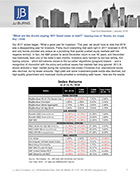After a strong June, major U.S. equity indexes were mixed in July, indicating some divergence and a potential shift in the narrative to come.
And so far, in limited trading sessions, August is showing a different tone. This change in tone is focused on a cooling economy, which has been the Fed’s plan all along by raising rates. However, nerves exist that a soft landing (cooling the economy without a recession) is no longer as likely.
Investors anxiously received mixed corporate earnings. In fact, earnings contributed to some selling in equities, especially megacap tech, towards the end of the month and into the first two trading sessions in August. All the while, value stocks and small-caps (companies with smaller market capitalizations) fared quite well in July.
Overall, here was the tale of the tape for the month of July: The S&P 500 increased by 1.13%, the Nasdaq 100 fell by 1.50%, and the Dow Jones Industrial Average rose by 4.41%.
Divergence Featured in July
For an extended period of time, the market narrative has been centered around AI and megacap tech, with names like NVIDIA and META powering major market indexes higher.
Well, narratives do change in the financial markets; the shift towards higher dividend-paying blue-chip value stocks and even underloved small-caps came into play as July progressed. But there was nowhere to hide once August got moving, with selling coming in across the board. More on that in a minute!
Be Diversified
Early August developments reinforced why a diversified portfolio — having an equity and fixed income portfolio properly constructed based on risk tolerance and other factors — is a must.
And while we all know that bonds are not nearly as trendy as a NVIDIA that split 10:1 back in June, it is prudence that makes the bacon for long-term investors.
Markets do not go up or down in a straight line, and diversification helps long-term investors weather storms.
Earnings Interpretations
It’s a busy earnings season, and there has been no shortage of earnings and overall market volatility as of late.
Many companies have shown mixed earnings, with some corporations missing the mark on top-line and bottom-line results. Technology stocks were sold heavily at the end of July and into the very beginning of August.
We are beyond the halfway point in the earnings season now, and we will see what the rest of it brings, with many tech giant earnings out of the way.
Inflation Cooling
So, here is the good news: Inflation is cooling. The recent data will factor into the Fed’s September policy meeting, where traders currently see a 100% chance of a rate cut — a 25.5% chance of a 25 basis point cut and a 74.5% chance of a 50 basis point cut.
Consumer Price Index (CPI): June consumer pricing, released in July, actually fell on a monthly basis, with monthly CPI data showing a 0.1% monthly decrease from May. This was two ticks lower than the Dow Jones estimate for a 0.1% monthly increase. Great news for the interest rate cut case!
Year-over-year, data showed a 3.0% increase — the lowest level in more than three years.
A 3.8% slide in gasoline pricing helped to tame the inflation reading, and even more good news was evident, as shelter and food costs were only 0.2% higher from a month ago. While still sticky, shelter inflation had the lowest monthly jump in three years, encouraging interest rate-cutting hopeful bulls.
Producer Price Index (PPI): After the soft CPI print, we got the June Producer Price Index (PPI), which ran hotter than estimates. Data showed wholesale pricing rose 0.2% in June, higher than the 0.1% Dow Jones estimate.
Looking at yearly data, wholesale data for June increased by 2.6%. So, while consumer pricing was lower, the wholesale pricing data was a bit warm — no inflation celebrations just yet!
Services pricing contributed to the rise in overall producer pricing, showing a 0.6% monthly gain that accounted for around three-quarters of the overall wholesale pricing gain.
July Fed Meeting
On the last day of July, the Federal Reserve (Fed) left rates unchanged as expected, keeping the federal funds rate at 5.25% – 5.50%.
The Fed statement included this note, “Recent indicators suggest that economic activity has continued to expand at a solid pace. Job gains have moderated, and the unemployment rate has moved up but remains low. Inflation has eased over the past year but remains somewhat elevated. In recent months, there has been some further progress toward the Committee’s 2 percent inflation objective.”
Market Reaction
The Fed decision day stimulated investors to bid equities higher as optimism grew surrounding rate cuts to come. Earnings from Meta after the bell on the same day helped to keep a bid under major stock indexes.
However, the buying enthusiasm was short-lived, as August began the next day. It was a volatile week on Wall Street, with the Fed in the rearview mirror and investors reacting to the next morning’s unemployment data, showing the highest level since October 2021.
Labor Market
On the note of softer economic data, let’s dig into the July labor market data release. The month’s labor market data missed the mark in a big way, triggering selling across major stock indexes and lower Treasury yields. Overall, 114,000 jobs were created versus Dow Jones estimates for 185,000.
This result was a big miss, especially given the earnings anxiety investors were coping with heading into the jobs number. However, it did cement the odds for a rate cut to come — this is what the market wanted for so long, anyway!
Moving forward, we’ll see how the market further digests the weaker employment data.
Putting It Together
Market narratives can change on a dime. July showed divergence in major stock indexes, with investor appetite shifting towards value stocks and underloved small-caps versus megacap tech, which could be interpreted as a shift in narrative and sentiment.
Economic data is also showing signs of slowing, which is exactly what the Fed has wanted to see to deliver beloved rate cuts. But now that we have the signs of such cooling, volatility has returned as selling accelerated in the first two trading sessions in August.
What To Do?
With the heavy selling we’ve seen at the start of August, it’s a good time to remember that the markets are always going to be volatile, and sometimes even more so now.
We don’t know how long this situation will last, but remember that volatility often brings opportunities. This is when rebalancing in portfolios becomes crucial, and we’ll stay focused on finding these opportunities, which are never emotionally driven.
As always, we will keep you updated with any new developments. If you would like to discuss the current market outlook or explore investment strategies that fit your goals, please reach out to us. We are here to help!
– Your Wealth Management Team at JJ Burns & Company
Disclosure: J.J. Burns & Company, LLC is a registered investment adviser with the U.S. Securities & Exchange Commission and maintains notice filings with the States of New York, Florida Pennsylvania, New Jersey, Connecticut, Georgia, Illinois, North Carolina, and California. J.J. Burns & Company, LLC only transacts business in states where it is properly registered, or excluded or exempted from registration. Follow-up and individualized responses to persons that involves either the effecting or attempting to effect transactions in securities, or the rendering of personalized investment advice for compensation, as the case may be, will not be made absent compliance with state investment adviser and investment adviser representative registration requirements, or an applicable exemption or exclusion.
All investing involves risk, including the potential for loss of principal. There is no guarantee that any investment plan or strategy will be successful.
The foregoing content reflects the opinions of J.J. Burns & Company, LLC and is subject to change at any time without notice. Content provided herein is for informational purposes only and should not be used or construed as investment advice or a recommendation regarding the purchase or sale of any security. There is no guarantee that the statements, opinions or forecasts provided herein will prove to be correct.
Past performance may not be indicative of future results. Indices are not available for direct investment. Any investor who attempts to mimic the performance of an index would incur fees and expenses which would reduce returns.
Securities investing involves risk, including the potential for loss of principal. There is no assurance that any investment plan or strategy will be successful.


